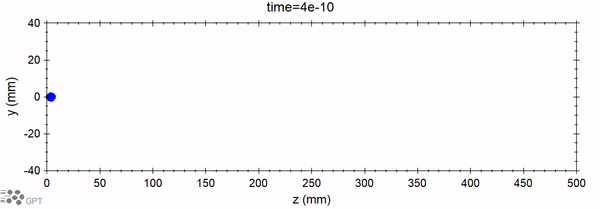Difference between revisions of "IONATOR"
(Created page with "Welcome to the IONATOR home page! 750px|right IONATOR is a custom element for the simulation of electron impact ionization in General Particle Tra...") |
|||
| Line 1: | Line 1: | ||
Welcome to the IONATOR home page! | Welcome to the IONATOR home page! | ||
| + | [[file:Bunch_result.gif|750px|right]] | ||
| − | |||
IONATOR is a custom element for the simulation of electron impact ionization in General Particle Tracer (GPT). It uses Monte Carlo algorithms to calculate ionization probabilities and secondary electron energies, then calculates the trajectories of the ion, secondary electron, and scattered electron using relativistic kinematics. Currently supported gas species are H<sub>2</sub>, He, CO, CO<sub>2</sub>, and CH<sub>4</sub>, though other gas species may be added in the future. IONATOR has been benchmarked against theoretical equations and against simulations made using IBSimu, an established ion tracking code (see [https://ibsimu.sourceforge.net/]). | IONATOR is a custom element for the simulation of electron impact ionization in General Particle Tracer (GPT). It uses Monte Carlo algorithms to calculate ionization probabilities and secondary electron energies, then calculates the trajectories of the ion, secondary electron, and scattered electron using relativistic kinematics. Currently supported gas species are H<sub>2</sub>, He, CO, CO<sub>2</sub>, and CH<sub>4</sub>, though other gas species may be added in the future. IONATOR has been benchmarked against theoretical equations and against simulations made using IBSimu, an established ion tracking code (see [https://ibsimu.sourceforge.net/]). | ||
Revision as of 16:14, 25 October 2022
Welcome to the IONATOR home page!
IONATOR is a custom element for the simulation of electron impact ionization in General Particle Tracer (GPT). It uses Monte Carlo algorithms to calculate ionization probabilities and secondary electron energies, then calculates the trajectories of the ion, secondary electron, and scattered electron using relativistic kinematics. Currently supported gas species are H2, He, CO, CO2, and CH4, though other gas species may be added in the future. IONATOR has been benchmarked against theoretical equations and against simulations made using IBSimu, an established ion tracking code (see [1]).
IONATOR was originally developed as part of my PhD thesis research, where I studied the efficacy of biasing the anode of the CEBAF photo-gun to mitigate ion damage and improve the operational lifetime (see Documents section below). While the custom element was made to study electron impact ionization within electron accelerators, it is readily applicable to other applications involving ionization.
The IONATOR package contains two custom elements for analysis: writeIonInfo and colorcoding. writeIonInfo, as its name suggests, writes ionization parameters to a separate GDF file for analysis. colorcoding, as its name suggests, allows the user to color code each particle by particle set. While these two custom elements were developed for use with IONATOR, they can be used independently of IONATOR.
To use IONATOR in your research, please send me an email at yoskowij@jlab.org with a brief description of what IONATOR will be used for. I will then send you the IONATOR package, which will contain:
- IONATOR (ionator.c and ionator_infofile.h)
- writeIonInfo.c
- colorcoding.c
- User Manual (PDF)
- Example files (described in the documentation)
License Disclaimer
While a great deal of time and effort went towards the development of IONATOR, my hope was for all GPT users to be able to use IONATOR in their research. Thus, IONATOR, writeIonInfo, colorcoding, and the user manual are licensed under the Creative Commons Attribution 4.0 International License. To view a copy of this license, please visit [2] or send a letter to Creative Commons, PO Box 1866, Mountain View, CA 94042, USA.
If using IONATOR in your published work, please use the following citation:
J. T. Yoskowitz et al., “Simulating Electron Impact Ionization Using a General Particle Tracer (GPT) Custom Element", Proc. 12th In. Particle Accelerator Conf. (IPAC ’21), Campinas, SP, Brazil (Virtual Conference), May 2021.
Documents
- IONATOR User Manual:
- IPAC'21 conference proceedings: [3]
